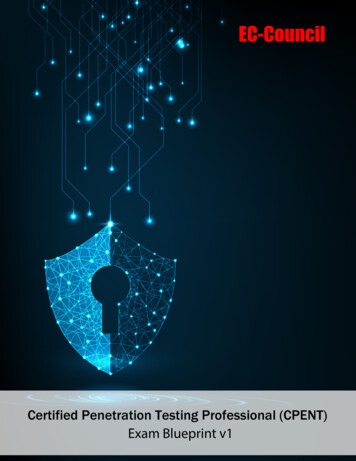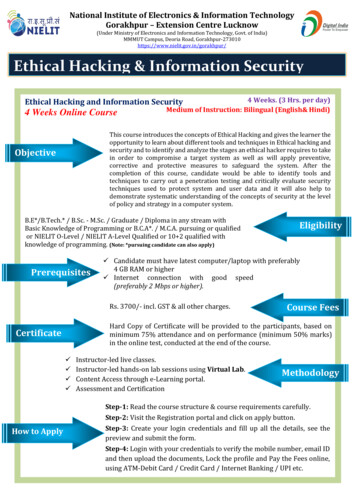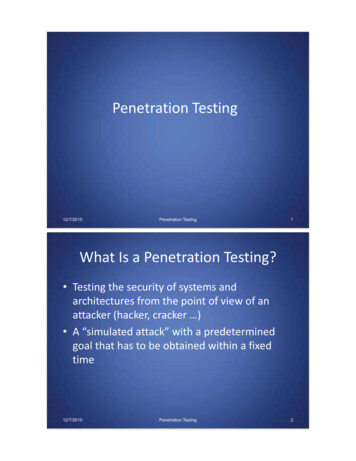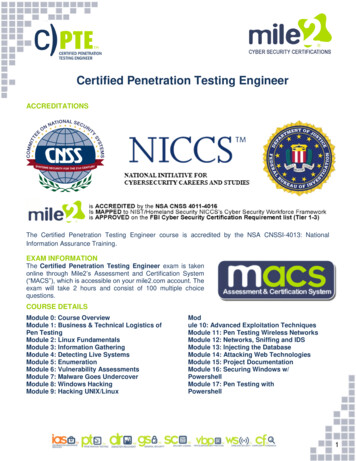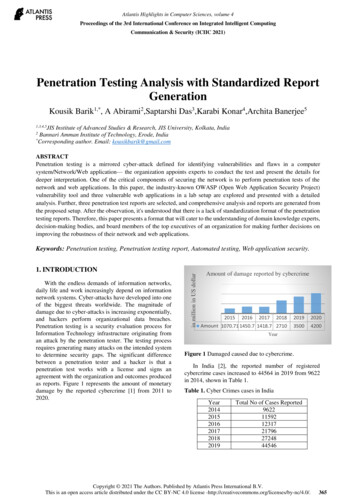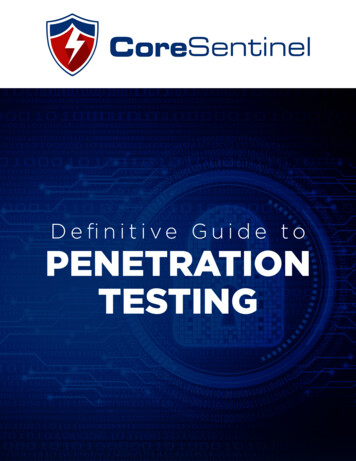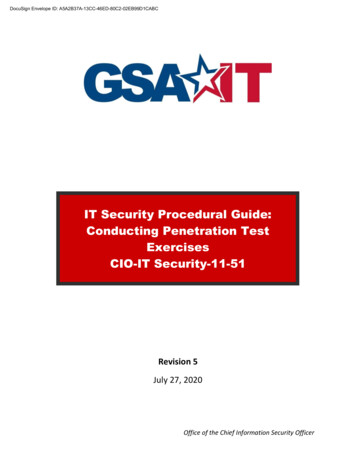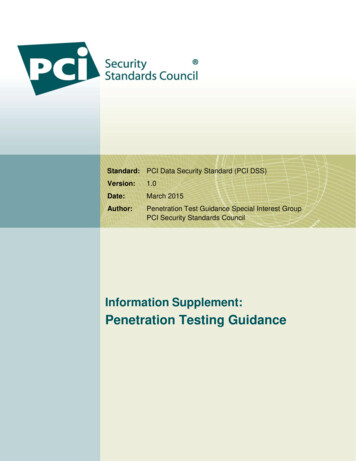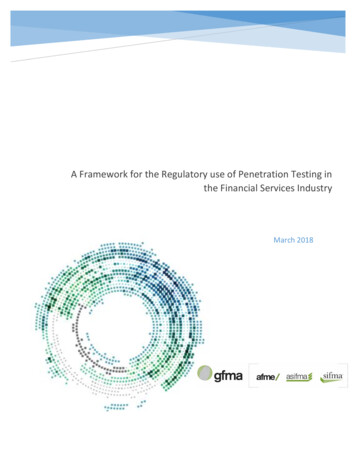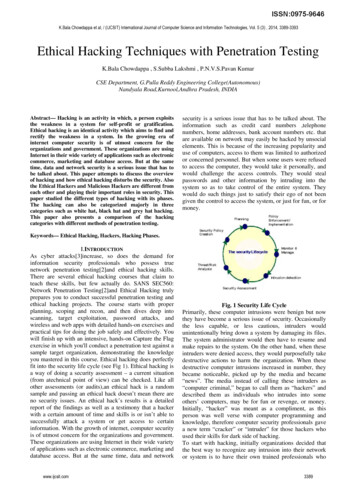
Transcription
K.Bala Chowdappa et al, / (IJCSIT) International Journal of Computer Science and Information Technologies, Vol. 5 (3) , 2014, 3389-3393Ethical Hacking Techniques with Penetration TestingK.Bala Chowdappa , S.Subba Lakshmi , P.N.V.S.Pavan KumarCSE Department, G.Pulla Reddy Engineering College(Autonomous)Nandyala Road,Kurnool,Andhra Pradesh, INDIAAbstract— Hacking is an activity in which, a person exploitsthe weakness in a system for self-profit or gratification.Ethical hacking is an identical activity which aims to find andrectify the weakness in a system. In the growing era ofinternet computer security is of utmost concern for theorganizations and government. These organizations are usingInternet in their wide variety of applications such as electroniccommerce, marketing and database access. But at the sametime, data and network security is a serious issue that has tobe talked about. This paper attempts to discuss the overviewof hacking and how ethical hacking disturbs the security. Alsothe Ethical Hackers and Malicious Hackers are different fromeach other and playing their important roles in security. Thispaper studied the different types of hacking with its phases.The hacking can also be categorized majorly in threecategories such as white hat, black hat and grey hat hacking.This paper also presents a comparison of the hackingcategories with different methods of penetration testing.security is a serious issue that has to be talked about. Theinformation such as credit card numbers ,telephonenumbers, home addresses, bank account numbers etc. thatare available on network may easily be hacked by unsocialelements. This is because of the increasing popularity anduse of computers, access to them was limited to authorizedor concerned personnel. But when some users were refusedto access the computer, they would take it personally, andwould challenge the access controls. They would stealpasswords and other information by intruding into thesystem so as to take control of the entire system. Theywould do such things just to satisfy their ego of not beengiven the control to access the system, or just for fun, or formoney.Keywords— Ethical Hacking, Hackers, Hacking Phases.I.INTRODUCTIONAs cyber attacks[3]increase, so does the demand forinformation security professionals who possess truenetwork penetration testing[2]and ethical hacking skills.There are several ethical hacking courses that claim toteach these skills, but few actually do. SANS SEC560:Network Penetration Testing[2]and Ethical Hacking trulyprepares you to conduct successful penetration testing andethical hacking projects. The course starts with properplanning, scoping and recon, and then dives deep intoscanning, target exploitation, password attacks, andwireless and web apps with detailed hands-on exercises andpractical tips for doing the job safely and effectively. Youwill finish up with an intensive, hands-on Capture the Flagexercise in which you'll conduct a penetration test against asample target organization, demonstrating the knowledgeyou mastered in this course. Ethical hacking does perfectlyfit into the security life cycle (see Fig 1). Ethical hacking isa way of doing a security assessment – a current situation(from atechnical point of view) can be checked. Like allother assessments (or audits),an ethical hack is a randomsample and passing an ethical hack doesn’t mean there areno security issues. An ethical hack’s results is a detailedreport of the findings as well as a testimony that a hackerwith a certain amount of time and skills is or isn’t able tosuccessfully attack a system or get access to certaininformation. With the growth of internet, computer securityis of utmost concern for the organizations and government.These organizations are using Internet in their wide varietyof applications such as electronic commerce, marketing anddatabase access. But at the same time, data and networkwww.ijcsit.comFig. 1 Security Life CyclePrimarily, these computer intrusions were benign but nowthey have become a serious issue of security. Occasionallythe less capable, or less cautious, intruders wouldunintentionally bring down a system by damaging its files.The system administrator would then have to resume andmake repairs to the system. On the other hand, when theseintruders were denied access, they would purposefully takedestructive actions to harm the organization. When thesedestructive computer intrusions increased in number, theybecame noticeable, picked up by the media and became“news”. The media instead of calling these intruders as“computer criminal,” began to call them as “hackers” anddescribed them as individuals who intrudes into someothers’ computers, may be for fun or revenge, or money.Initially, “hacker” was meant as a compliment, as thisperson was well verse with computer programming andknowledge, therefore computer security professionals gavea new term “cracker” or “intruder” for those hackers whoused their skills for dark side of hacking.To start with hacking, initially organizations decided thatthe best way to recognize any intrusion into their networkor system is to have their own trained professionals who3389
K.Bala Chowdappa et al, / (IJCSIT) International Journal of Computer Science and Information Technologies, Vol. 5 (3) , 2014, 3389-3393would attempt to break into their systems and wouldidentify, if there are any intrusion threats. Theseprofessionals, termed as “Red teams” or “ethical hackers”,follow same steps and tools as that of malicious hackers,but the difference is of there intensions. Ethical hackershave clear intensions to break computer security to save theorganization from intrusion attacks. They never reveal thefacts and information about the organization. But at anymoment of time, if there intensions get sidetracked; theywould be the one who would harm the most. This methodof recognizing any intrusions into the network and systemswas also used by United States Air Force. They conducteda “security evaluation” of the Multics operating systems fora two-level (secret/top secret) system. Their evaluationfound that while Multics was significantly better than otherconventional systems, it also had loopholes in hardware,software and procedural security. .The hackers performedvarious penetration tests[4] such as information-gathering,to identify any threat that might damage its integrity.II. ABOUT HACKINGHacking is a brainchild of curiosity. As a result ofcuriosity, the hacker always wants to know more aboutinformation, depending upon his taste. A hacker is a personwho enjoys learning the details of computer systems andenhances his capabilities. He is a computer enthusiast andextremely proficient in programming languages, computersystems and networks. Popularly, hackers are referred tosomeone who penetrates into computer network securitysystems. It is the hackers who built Internet and make wwwto work. The operating system UNIX is a gift from hackerstoo. Originally, the term hacking was defined as-“ A personwho enjoys learning the details of computer systems andhow to stretch their capabilities-as opposed to most users ofcomputers, who prefer to learn only the minimum amountnecessary. One who programs enthusiastically or whoenjoys programming rather than just theorizing aboutprogramming”.They does not break into systems without authorizationrather they are the experts who safeguard the networks ofan organization. They attack the organizations’ systems toidentify any loopholes, if any, in the security, all whilestaying within the legal limits. Ethical hacking[5] is alsoknown as “Penetration Hacking” or “Intrusion Testing” or“Red Teaming”. Malicious hacking[2] is the unauthorizeduse of computer and network resources. Malicious hackersuse software programs such as Trojans, malware andspyware, to gain entry into an organization’s network forstealing vital information. It may result to identity theft,loss of confidential data, loss of productivity, use ofnetwork resources such as bandwidth abuse and mailflooding, unauthorized transactions using credit or debitcard numbers, selling of user’s personal details such asphone numbers, addresses, account numbers etc. In generalpublic view, they are the “Criminals of the Cyber World”,who has a malicious desire to destroy and harm someoneothers’ network and data. Malicious Hackers are alsoknown as “Crackers”. Hackers, be the ethical or malicious,have in depth knowledge of their skills but the onlydifference that makes them diverse is the intension.www.ijcsit.comEthical hackers are very patient. They only demandtime and persistence to intrude into the system and find theloopholes in the security. This vital trait of patience canalso be seen in malicious hacker as he too would keep thepatience and would monitor the target system for weeks ormay be for months, and would wait for an opportunity toattack the target. The difference is that an ethical hackerwould keep patience to test the target against any securitybreech while the malicious hacker would keep patience soas to gather information and find an opportunity that isrelevant to attack the target system. It may be observed thatall techniques and skills employs to both ethical andmalicious hackers. It is only the intension of the hackersthat makes them diverse. An ethical hacker would alwaysuse these techniques and skills to find the weaknesses ofthe target system and how to deal against any maliciousattacks, whereas the malicious hacker would always try touse the techniques and skills to attack the target so as toharm and destroy it for some personal interest like money.It may be said that the ethical hackers’ job is tough ascompared to malicious one. This is because an ethicalhacker would have to identify and understand the changesdone in the network by the malicious hacker.III. TYPES OF HACKING/HACKERSThe hacking can be classified in three different categories,according to the shades or colors of the “Hat”. The wordHat has its origin from old western movies where the colorof Hero’s’ cap was “White” and the villains’ cap was“Black”. It may also be said that the lighter the color, theless is the intension to harm. White Hat Hackers areauthorized and paid person by the companies, with goodintends and moral standing. They are also known as “ITTechnicians”. Their job is to safeguard Internet, businesses,computer networks and systems from crackers. Somecompanies pay IT professionals to attempt to hack theirown servers and computers to test their security. They dohacking for the benefit of the company. They break securityto test their own security system. The white Hat Hacker isalso called as an Ethical Hacker[6]. In contrast to WhiteHat Hackers, the intension of Black Hat Hackers is to harmthe computer systems and network. They break the securityand intrude into the network to harm and destroy data inorder to make the network unusable. They deface thewebsites, steal the data, and breach the security. They crackthe programs and passwords to gain entry in theunauthorized network or system. They do such things fortheir own personal interest like money. They are alsoknown as “Crackers” or Malicious Hackers.3390
K.Bala Chowdappa et al, / (IJCSIT) International Journal of Computer Science and Information Technologies, Vol. 5 (3) , 2014, 3389-3393Other than white hats and black hats, another form ofhacking is a Grey Hat. As like in inheritance, some or allproperties of the base class/classes are inherited by thederived class, similarly a grey hat hacker inherits theproperties of both Black Hat and White Hat. They are theones who have ethics. A Grey Hat Hacker gathersinformation and enters into a computer system to breechthe security, for the purpose of notifying the administratorthat there are loopholes in the security and the system canbe hacked. Then they themselves may offer the remedy.They are well aware of what is right and what is wrong butsometimes act in a negative direction. A Gray Hat maybreach the organizations’ computer security, and mayexploit and deface it. But usually they make changes in theexisting programs that can be repaired. After sometime, itis themselves who inform the administrator about thecompany’s security loopholes. They hack or gainunauthorized entry in the network just for fun and not withan intension to harm the Organizations’ network. Whilehacking a system, irrespective of ethical hacking (white hathacking) or malicious hacking (black hat hacking), thehacker has to follow some steps to enter into a computersystem, which can be discussed as follows.IV. HACKING PHASESHacking Can Be Done By Following These Five Phases.Phase 1: Reconnaissance Can Be Active Or Passive: InPassive Reconnaissance[4] The Information is gatheredregarding the target without Knowledge of targetedcompany (Or Individual). It could be done simply bySearching Information Of The Target On Internet OrBribing An Employee Of Targeted Company Who WouldReveal And Provide Useful Information To The Hacker.This Process Is Also Called As “Information Gathering”. InThis Approach, Hacker Does Not Attack The System OrNetwork Of The Company To Gather Information.Whereas In Active Reconnaissance, The Hacker Enters IntoThe Network To Discover Individual Hosts, Ip AddressesAnd Network Services. This Process Is Also Called As“Rattling The Doorknobs”. In This Method, There Is AHigh Risk Of Being Caught As Compared To PassiveReconnaissance.Phase 2: Scanning: In Scanning Phase, The InformationGathered In Phase 1 Is Used To Examine The Network.Tools LikeDiallers, Port Scanners Etc. Are Being Used bythe Hacker to Examine the Network So As To Gain Entryin the Company’s System And Network.Phase 3: Owning The System: This Is The Real AndActual Hacking Phase. The Hacker Uses The InformationDiscovered In Earlier Two Phases To Attack And EnterInto The Local Area Network(Lan, Either Wired OrWireless), Local Pc Access, Internet Or Offline. This PhaseIs Also Called As “Owning The System”.Phase 4: Zombie System: Once the hacker has gained theaccess in the system or network, he maintains that accessfor future attacks (or additional attacks), by makingchanges in the system in such a way that other hackers orsecurity personals cannot then enter and access the attackedsystem. In such a situation, the owned system (mentionedin Phase 3) is then referred to as “Zombie System”.www.ijcsit.comFig. 2 Hacking PhasesPhase 5: Evidence Removal: In this phase, the hackerremoves and destroys all the evidences and traces ofhacking, such as log files or Intrusion Detection SystemAlarms, so that he could not be caught and traced. This alsosaves him from entering into any trial or legality. Now,once the system is hacked by hacker, there are severaltesting methods available called penetration testing todiscover the hackers and crackers.V. TESTING STRATAGIES External testing strategy. External testing refers to attackson the organization's network perimeter using proceduresperformed from outside the organization's systems, that is,from the Internet or Extranet. This test may be performedwith non-or full disclosure of the environment in question.The test typically begins with publicly accessibleinformation about the client, followed by networkenumeration, targeting the company's externally visibleservers or devices, such as the domain name server (DNS),e-mail server, Web server or firewall. Internal testing strategy. Internal testing is performed fromwithin the organization's technology environment. This testmimics an attack on the internal network by a disgruntledemployee or an authorized visitor having standard accessprivileges. The focus is to understand what could happen ifthe network perimeter were successfully penetrated or whatan authorized user could do to penetrate specificinformation resources within the organization's network.The techniques employed are similar in both types oftesting although the results can vary greatly. Blind testing strategy. A blind testing strategy aims atsimulating the actions and procedures of a real hacker. Justlike a real hacking attempt, the testing team is provided3391
K.Bala Chowdappa et al, / (IJCSIT) International Journal of Computer Science and Information Technologies, Vol. 5 (3) , 2014, 3389-3393with only limited or no information concerning theorganization, prior to conducting the test. The penetrationtesting team uses publicly available information (such ascorporate Web site, domain name registry, Internetdiscussion board, USENET and other places ofinformation) to gather information about the target andconduct its penetration tests. Though blind testing canprovide a lot of information about the organization (socalled inside information) that may have been otherwiseunknown, for example, a blind penetration may uncoversuch issues as additional Internet access points, ntial/proprietary information, etc. But it is moretime consuming and expensive because of the effortrequired by the testing team to research the target. Double blind testing strategy. A double-blind test is anextension of the blind testing strategy. In this exercise, theorganization's IT and security staff are not notified orinformed beforehand and are "blind" to the planned testingactivities. Double-blind testing is an important componentof testing, as it can test the organization's securitymonitoring and incident identification, escalation andresponse procedures. As clear from the objective of thistest, only a few people within the organization are madeaware of the testing. Normally it's only the project managerwho carefully watches the whole exercise to ensure that thetesting procedures and the organization's incident responseprocedures can be terminated when the objectives of thetest have been achieved. Targeted testing strategy. Targeted testing or the lightsturned-on approach as it is often referred to, involves boththe organization's IT team and the penetration testing teamto carry out the test. There is a clear understanding of thetesting activities and information concerning the target andthe network design. A targeted testing approach may bemore efficient and cost-effective when the objective of thetest is focused more on the technical setting, or on thedesign of the network, than on the organization's incidentresponse and other operational procedures. Unlike blindtesting, a targeted test can be executed in less time andeffort, the only difference being that it may not provide ascomplete a picture of an organization's securityvulnerabilities[7] and response capabilities. While there areseveral available methodologies for you to choose from,each penetration tester must have their own methodologyplanned and ready for most effectiveness and to present tothe client.Table 1Comparative Study Of Penetration Testing W.R.T ThePerspectiveswww.ijcsit.comThe chart is prepared based for the categories involved onthe data involved considering the presence as 1 and absenceas 0. Also the chart for the testing method as penetrationtest involves for the category. The chart is shown in Fig.3and Fig.4Fig. 3 Categories as Total Outsider, Semi-Outsider andValid userFig. 4 Testing Methods involved with types hackingAccording to the table described above, the valid user is ahacker who has access to every piece of information anddata of the organization, using any testing methods ascompared to other two categories of total or outsider user.Semi outsiders have access to data by all methods acceptthe physical entry method. The total outsider is involvedless as compared to the other two as they cannot accessdata using some methods like remote dial-up network,Local network and physical entry. This study reveals that avalid user is boon for organization till his intensions areclear; otherwise he is the one who can harm the most as hehas the access to every information and data. The semioutsider comes after the valid user. And the total outsideruser is of least concern.Here are my top five strategies for network pen testing.A. Test all the thingsIn many environments that I’ve worked in, the IT securitygroup is primarily concerned with their most sensitive datastores when it comes to penetration tests. This can createhuge gaps in the vulnerability identification (andremediation) process that could allow an attacker to easilypivot to sensitive systems. Make sure you hit your sensitive3392
K.Bala Chowdappa et al, / (IJCSIT) International Journal of Computer Science and Information Technologies, Vol. 5 (3) , 2014, 3389-3393data stores, but pay close attention to the other hosts onyour domain that could be compromised and used to get tosensitive data stores.B. Networks, networks, networksI see network layer protocol issues on almost everynetwork penetration test. From ARP spoofing (old) toNBNS and LLMNR[7] spoofing (newer), network issuestypically play a huge role in a penetration test. Most ofthese issues put an attacker in a man-in-the-middle positionthat’s perfect for capturing credentials (unencrypted andhashes) and relaying credentials. Additional network issuesthat should be tested include VLAN hopping (tag spoofing)and DTP spoofing. These issues can grant an attackeraccess to sensitive VLANs and/or all of the traffic headedto and from those VLANs.C . Brute Force All the SeasonsIf you’re testing internally, I can’t stress this enough. Doroutine audits (weekly, monthly, and/or quarterly) of weakpasswords. This can be as simple as doing a quick onepassword check (Winter2014), to dumping and crackingyour domain hashes. If you’re going the dump and crackmethod, make sure you are taking extra precautions toprotect those hashes during and after cracking. Any usersidentified with a weak password should get a friendlynotification email, followed by a forced password reset, ifthey don’t change it by the end of the day. If you want toincentivize users, inform users of the plan to auditpasswords and have some small prize for users that are onthe good list.Interested in building your own cracking system forinternal password auditing? Come see Eric Gruber and meat our “GPU Cracking, On the Cheap” talk on Wednesday(9:45 AM).D. Automated Scanners – Trust, but VerifyYou can typically trust (most) automated scanners, but theycan be filled with false positives. Even worse, they maycause you to miss critical (entry point) vulnerabilities thatshow up in the lower severities. Take memcached forinstance. The Nessus plugin[4] shows up as a medium,however I’ve seen memcached store database and localadministrator credentials in cached data. This has resultedin immediate local administrator access to systems. Doyour best to fully vet out listening services, even if there’sno scan data indicating serious vulnerabilities.E. Check Your Web AppsWe frequently use web applications as entry points duringinternal penetration tests. For external testing, web apps arean extremely common entry point. Even light testing oninternal apps can expose critical vulnerabilities, likedirectory traversal and SQL injection. Making sure you testyour applications along with a network test will help coveryour bases.security needs, the malicious hackers intrudes illegally andharm the network for their personal benefits.An Ethical[5]and creative hacking is significant in network security, inorder to ensure that the company’s information is wellprotected and secure. At the same time it allows thecompany to identify, and in turn, to take remedial measuresto rectify the loopholes that exists in the security system,which may allow a malicious hacker to breach theirsecurity system. They help organizations to understand thepresent hidden problems in their servers and corporatenetwork. The study also reveals that the valid users are theethical hackers, till their intensions are clear otherwise theyare a great threat, as they have the access to every piece ofinformation of the organization, as compare to total andsemi outsiders.This also concludes that hacking is an important aspect ofcomputer world. It deals with both sides of being good andbad. Ethical hacking[5]plays a vital role in maintaining andsaving a lot of secret information, whereas malicioushacking can destroy everything. What all depends is theintension of the hacker. It is almost impossible to fill a gapbetween ethical and malicious hacking[5] as human mindcannot be conquered, but security measures can be tighten.ACKNOWLEDGMENTWe would like to give special thanks to P.N.V.S.PavanKumar, and S.Subbalakshmi, Assistant Professors in CSEDepartment of G.Pulla Reddy Engineering College, whoparticipated in paper preparation and provided valuablesuggestions in Successful completion of this paper.Thanks for all my faculty members, students and otherauthors who directly or indirectly supported me in writingthis journal.REFERENCES[1]. Agarwal, Ankit Kumar, Hacking : Research paper, onlinehttp://ankitkumaragarwal.com /hacking-a-research-paper/ (visited onmay 2012)[2]. Wilhelm, Douglas. "2". Professional Penetration Testing.SyngressPress. p. 503.ISBN 978-1-59749-425-0[3]. Moore, Robert (2006). Cybercrime: Investigating High-TechnologyComputer Crime (1st ed.). Cincinnati, Ohio: Anderson Publishing.ISBN 978-1-59345-303-9[4]. EC-Council (n.d.). Ethical Hacking and Countermeasures, onlinehttp://www.eccouncil.org/ ipdf/EthicalHacker.pdf (visited on tp://www.go4expert.com/forums/showthread.php?t 11925(visited on may 2012)[6]. Palmer, C.C.(2001,April 13). Ethical Hacking. IBM Systems JournalVol. 40 No.3 2001[7]. About Effective Penetration Testing Methodology byByeong-HoKANGCONCLUSIONHacking[1] has both its benefits and risks. Hackers are verydiverse. They may bankrupt a company or may protect thedata, increasing the revenues for the company. The battlebetween the ethical or white hat hackers and the maliciousor black hat hackers is a long war, which has no end. Whileethical hackers[5] help to understand the companies’ theirwww.ijcsit.com3393
information security professionals who possess true network penetration testing[2]and ethical hacking skills. There are several ethical hacking courses that claim to teach these skills, but few actually do. SANS SEC560: Network Penetration Testing[2]and Ethical Hacking truly prepares you to conduct successful penetration testing and
